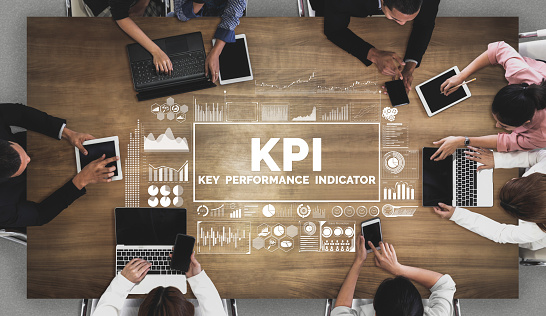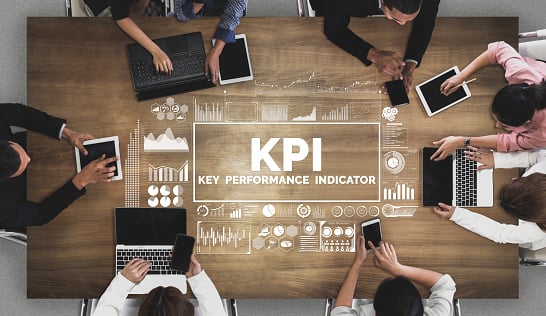
What’s A Good Website Session To Customer Conversion Rate?
 Conversion rate is a common metric when it comes to marketing. It’s calculated by the number of people who share contact information with you divided by the number of people coming to your website. If you get 1,000 visitors a month and you generate 10 net new contacts, your conversion rate is 1%.
Conversion rate is a common metric when it comes to marketing. It’s calculated by the number of people who share contact information with you divided by the number of people coming to your website. If you get 1,000 visitors a month and you generate 10 net new contacts, your conversion rate is 1%.
But when you look at industry data and try to understand what a solid site-wide conversion rate is, it’s foggy at best.
WordStream research found that “across industries, the average landing page conversion rate was 2.35%, yet the top 25% are converting at 5.31% or higher.”
However, that is for landing pages, and we’re looking at site-wide conversion rates. This means it’s going to be lower, as quite a few pages on your site are designed to educate and not convert.
I’d like to suggest that this metric isn’t as relevant as it used to be, especially as progressive marketers stop gating their content and allow everyone who visits to get anything they want without giving their contact information.
If that’s the case, then what other metrics should you be looking at? One that I like is the percentage of website visitors to new customers. Radical, right? It’s actually connecting marketing to customers and revenue.
Website Visitors To New Customers Conversion Rate
This is pretty simple. If you signed 10 new customers this month and you had 10,000 visitors to your website during the month, your visitors to new customers conversion rate would be .1%.
This metric highlights how solid your marketing and sales execution is at taking visitors and turning them into revenue. Yes, a lot happens between visit and close, but that’s your revenue cycle nonetheless.
By working to improve this number, you can then focus on driving visitors to your website and have the ability to forecast revenue based on those visitors’ numbers.
What’s A Good Number, Average Number Or Number That Needs Improvement?
We run revenue cycles for all of our clients, so we’ve been studying this metric for a number of years.
Typically, clients come to us with visitor to customer conversion rates between .02% and .2%. The last four new clients we started working with had numbers like this – .025%, .05%, .2% and .02%.
One of these clients saw their metric go from .02% to .05%, a 150% improvement. Another client went from .2% to .233%, a 16.5% improvement. This might seem like a small number, but this metric is one of the only numbers that highlights your full revenue cycle from click to close, and it shows how efficiently both marketing and sales are at moving visitors through to close.
Averages Aren’t Relevant
How do you compare to these averages? I’m not sure that’s relevant. Every business is different, and every revenue cycle is unique to the business.
What you should be looking at is baseline conversion rates, as they do exist today, and then working to improve your number month over month. This continuous improvement mindset is what you’re looking to install in your company and around your marketing effort.
Now that you’re tracking it and working to improve it, start looking at what you can do in the short term (today), medium term (this month) and long term (over the next six months) to keep making improvements.
How To Improve The Visitor To Customer Conversion Rate
Since this number represents your entire buyer journey from click to close, you could work to improve this number in a number of areas. Interestingly enough, getting more visitors to your website is NOT one of them.
This is usually good news because SEO has become challenging and more of a long-term marketing initiative. Social media is challenging due to so many poorly executed content and ad programs. Referrals and backlinks are hard to come by, and email is overused and generally only so effective.
But once you convert people on your website and you’re able to nurture them through their buyer journeys, you can deploy tactics to improve these conversion rates, and then in kind, your visitors to new customers conversion rate.
Conversion Rate Optimization – Once people land on your website, you have two tools in your tool kit. The website experience includes the story, the pages, the flow and the feeling the site delivers. You also have the content on the website and how you leverage that content to educate your prospects and ultimately get them to convert from an anonymous visitor to a new contact.
With more and more marketers ungating their content, this conversion is more challenging. Yes, more people are seeing your content, but fewer new contacts are created.
If you’re ungating most of your early buyer journey educational content in the hopes that you’ll build your brand, then you MUST work harder on later-stage buyer journey conversion points on your website.
As an example, demos for software companies are typical late-stage buyer journey offers, but many alternatives exist, even for software companies.
We recently started working with an insurance company that has a free insurance review or audit for their late-stage buyer journey offer. We’ve done similar assessments for other companies. We even had warehouse managers submit pictures of their concrete floors for a concrete floor finishing company to do a review and recommendation from those pics.
The opportunities are endless for value-oriented offers that drive up the conversion rate.
Retargeting – Another alternative is running retargeting ads for people who visit later-stage buyer journey pages on your website. If someone visits your pricing page, it might be a signal that they’re considering you or companies like yours. If they visit your team page, this might be a signal that they are further along in their buyer journey.
Sending them additional value-oriented banner ads while they explore the web could get them back to your site and into your sales cycle.
Make sure those ads serve up value-oriented offers, not educational content. They’re done with education; they are into the consideration and decision-making phases, so give them a chance to get something from the conversation with your company.
Lead Nurturing – Once you get them to provide an email address, consider a lead nurturing sequence of emails. A nurture sequence can also pull people through their buyer journey and influence them, as long as the content offers are strong, the emails are well written and you’re not selling to them.
Please don’t ask for a meeting. Instead, speak to them empathetically from a position of understanding and earn their trust.
Don’t elongate these nurture sequences. If someone doesn’t engage after three emails, cut it off and move on. They know how to get in touch with you.
If you keep the emails short, concise and chock-full of additional opportunities for them to learn, for you to add value or for them to get to know you better, you can drive up conversion rates.
Content for Sales – Once you get someone to engage with sales, the sales reps have to engage productively. No pushy sales tactics, just continued education, advice and good guidance for their journey. You want to help, not sell.
One way to make this experience richer is to arm the sales reps with content that they can deliver in context to their sales conversations. This might include tip guides, playbooks, videos, infographics, glossaries or anything that helps prospects feel safe in choosing to work with your team.
One of the best ways to start working on this is to ask the salespeople what questions they get asked the most, what prospects are most concerned about and what topics prospects bring up the most. This can help inform your content marketing and content for sales strategy for months.
Lead Scoring – If you want to improve your conversion rates across the company’s revenue cycle, then look at lead scoring as a way to get your reps working on your best potential prospects.
Lead scoring can include using demographic, psychographic and on-site behavior along with sales-rep-collected data to create a score that indicates a propensity to close.
This allows reps to spend their time working with the highest potential opportunities to increase conversion rate at every stage in your revenue cycle.
Prospects with lower scores can be served automated nurtures until their scores or level of interest or activity increases.
Sales Process Improvements – Finally, your sales process is going to have a major impact on conversion rates post-discovery call into the diagnostic and down through the proposal and final close stages.
If you have a clunky or company-centric process, these conversion rates are going to be low. If you have a guided sales process that focuses on your prospect, if you educate those prospects and if you design a process that makes them feel safe working with your company, you’ll notice conversion rates increasing across the buyer journey cycle.
So many sales process improvements represent low-hanging fruit for most companies.
How do you handle references? Do you wait until your prospect meets with a customer, or do you serve up videos of customers proactively before prospects even ask for references? This one step has cut weeks off multiple clients’ sales processes.
Is your agreement or contract heavy on legal terminology? If the legal department has to get involved, it’s too litigious. Consider making it more business-oriented and written for a businessperson, not a lawyer.
What about your final pitch? Do you surprise your prospect with pricing, terms and the details of your recommendations? If you do, then consider co-creating each part of the recommendations before your final meeting.
You should even consider sharing and socializing the price within their organization, so when you present, they’ve seen it before, agreed to it in principle and are comfortable that they participated in the process.
This can increase your close rate by 10% to 20%, which translates to revenue and a more scalable, predictable revenue generation machine.

CEO and Chief Revenue Scientist
Mike Lieberman, CEO and Chief Revenue Scientist
Eliminate Hit-or-Miss Marketing Moves
Get advice, tips, tools and guidance to generate more leads for your company in this weekly email newsletter.



Eliminate Hit-or-Miss Marketing Moves
Get advice, tips, tools and guidance to generate more leads for your company in this weekly email newsletter.














